#Gruffudd ap Llywelyn
Text
Time Travel Question 44: Medievalish History 8 and Earlier
These Questions are the result of suggestions from the previous iteration.
This category may include suggestions made too late to fall into the correct earlier time grouping. Basically, I'd already moved on to human history, but I'd periodically get a pre-homin suggestion, hence the occasional random item waaay out of it's time period, rather than reopen the category.
In some cases a culture lasted a really long time and I grouped them by whether it was likely the later or earlier grouping made the most sense with the information I had. (Invention ofs tend to fall in an earlier grouping if it's still open. Ones that imply height of or just before something tend to get grouped later, but not always. Sometimes I'll split two different things from the same culture into different polls because they involve separate research goals or the like).
Please add new suggestions below if you have them for future consideration. All cultures and time periods welcome.
#Time Travel#Timbuktu#Middle Ages#Minoan#Fashion History#History of Food#Ancient World#Gruffudd ap Llywelyn
39 notes
·
View notes
Text
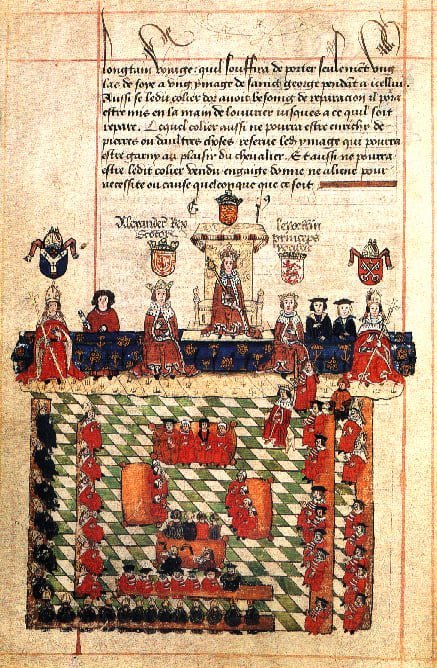
On December 25th 1251 Alexander III was knighted by Henry III of England. Born in 1241, he had become King on his father Alexander II's death in 1249, at the age of 7.
Alexander III was only a child when he became king but his reign would come to be seen as a golden age in Scottish history. Alexander needed to restore unity following the divisions of his minority, re-establish Scottish independence from the encroaching ambitions of England and finished his father’s work in recovering the Western Isles from Norway – a pretty big to-do list but he accheived all this and possibly more, it's such a shame we lost him aged only 37, but without his death we might never had the likes of Wallace, The Bruce and the Good Sir James Douglas to decorate our history.
Anyway, the story of his knighting by the English King is a tale to make you proud of him. Henry III was keen to assert his influence and see through a deal he made with Alexander II that their children would marry, so in 1251 Alexander III (now 10) came to York where he was knighted by Henry before marrying Henry’s daughter, Margaret who was aged 11 at the time. Henry began pressuring Alexander to swear fealty to Henry and England. Alexander sidestepped the demands, until after Edward I succeeded Henry III, when, with carefully chosen words, he swore this: “I become your man for the lands I hold of you in the Kingdom of England for which I owe homage, saving my Kingdom.” Basically saying his homage is only as a guest of the English but not in Scotland.
Of course after Alexander died Henry's son Edward, Longshanks stepped up the efforts to subjugate Scotland, heralding the time of the three Scottish heroes I mentioned earlier.
The pic is a 16th-century illustration of Edward I presiding over Parliament. The scene shows Alexander III and Llywelyn ap Gruffudd of Wales on either side of Edward; an episode that never actually occurred, but I would assume Edward would have loved to have these two serve under him.
18 notes
·
View notes
Text
Diwrnod Llywelyn ein Llyw Olaf hapus
Happy Llywelyn the Last day
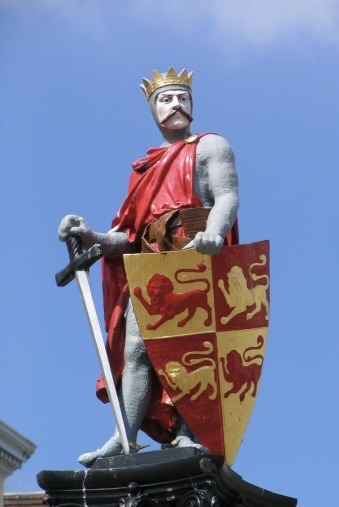
Llywelyn ap Gruffudd oedd Tywysog olaf Cymru cyn concwest Edward y Cyntaf, a’r cyntaf i gael ei gydnabod fel hynny gan Frenin Lloegr. Sefydlwyd ef fel Tywysog Cymru gyda’r nôd i uno Cymru; nôd a chafodd ei wneud yn anodd iawn gan brenhinoedd Lloegr. Cafodd ei eni tua 1223 a bu farw ar y cyntaf ar ddeg o Ragfyr 1282.
Llywelyn son of Gruffudd was the last Tywysog (roughly meaning leader or guide) of Wales before the conquest of Edward the First, and the first to be recognised as such by the King of England. He rose with the goal to unite Wales; a goal which was made difficult by opposing English rulers. He was born around 1223 and died on the eleventh of December 1282.
Mae’n ddrwg gen i bostio hwn mor hwyr, darganfyddais i ei fod hi’n ddiwrnod Llywelyn ond pan welais i’r ebost golwg360 lol
Sorry for posting this so late, I only realised it was Llywelyn day when i saw the golwg360 email lol
#diwrnod llywelyn ein llyw olaf#llywelyn the last day#llywelyn ein llyw olaf#llywelyn the last#hanes cymru#welsh history#cymru#wales#gwyliau cymraeg#welsh holidays#tymblr
2 notes
·
View notes
Note
For the meme: tell us your weirdest piece of random history knowledge? OR tell us your dream historical find, like the unicorn historical artefact or whatnot that you wish you'd spot in a cardboard box at a car boot sale.
Ooooh i like this one!
Ok my weirdest piece of random historical knowledge is probably that Gruffudd ap Llywelyn ab Iorwerth, a son of Llywelyn the Great, Prince of Wales, was imprisoned in the Tower of London and attempted to escape by tying his bedsheets together and using them as a rope to climb out the window. Just to be extra patriotic he did it on St David's Day 1244.
As you can see from this illustration, it did not go well.
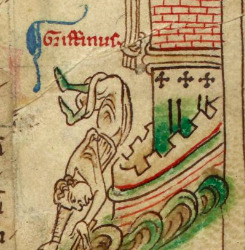
Since getting into The Beatles my archival unicorn would be finding one of the hand drawn Nerk Twins posters John Lennon and Paul McCartney made when they played as a duo in a pub in Caversham in 1960. Can you IMAGINE going through a new archival accession and unfolding that 😲
7 notes
·
View notes
Quote
Historically, a sword identified as Excalibur (Caliburn) was supposedly discovered during the purported exhumation of Arthur's grave at Glastonbury Abbey in 1191.[26] On 6 March 1191, after the Treaty of Messina, either this or another claimed Excalibur was given as a gift of goodwill by the English king Richard I of England (Richard the Lionheart) to his ally Tancred, King of Sicily.[27] It was one of a series of Medieval English symbolic Arthurian acts, such as associating the crown won from the slain Welsh prince Llywelyn ap Gruffudd with the crown of King Arthur
Excalibur - Wikipedia
such as associating the crown won from the slain Welsh prince Llywelyn ap Gruffudd with the crown of King Arthur
#we learn our history so we don't repeat it#this is the time to awaken Arthur#Arthur is welsh#merlin is Myrddin and lives in camarthen#independence is crawling ever near#welsh cultus#tylwyth teg#iolo morganwg was a liar#local folklore#the welsh gods#hud#cymraeg polytheism#welsh polytheism#welsh witchcraft#you shouldn't have removed your fathers head from the white hill Arthur!
16 notes
·
View notes
Text
re: last reblog i forgot Llywelyn ap Gruffudd. i’m so sorry. fake fan. i can never make up for this
0 notes
Text
Events 12.11 (before 1950)
220 – Emperor Xian of Han is forced to abdicate the throne by Cao Cao's son Cao Pi, ending the Han dynasty.
361 – Julian enters Constantinople as sole Roman Emperor.
861 – Assassination of the Abbasid caliph al-Mutawakkil by the Turkish guard, who raise al-Muntasir to the throne, start of the "Anarchy at Samarra".
969 – Byzantine Emperor Nikephoros II Phokas is assassinated by his wife Theophano and her lover, the later Emperor John I Tzimiskes.
1041 – Michael V, adoptive son of Empress Zoë of Byzantium, is proclaimed emperor of the Eastern Roman Empire.
1282 – Battle of Orewin Bridge: Llywelyn ap Gruffudd, the last native Prince of Wales, is killed at Cilmeri near Builth Wells in mid-Wales.
1602 – A surprise attack by forces under the command of Charles Emmanuel I, Duke of Savoy, and his brother-in-law, Philip III of Spain, is repelled by the citizens of Geneva. (Commemorated annually by the Fête de l'Escalade.)
1640 – The Root and Branch petition, signed by 15,000 Londoners calling for the abolition of the episcopacy, is presented to the Long Parliament.
1675 – Antonio de Vea expedition enters San Rafael Lake in western Patagonia.
1688 – Glorious Revolution: James II of England, while trying to flee to France, throws the Great Seal of the Realm into the River Thames.
1792 – French Revolution: King Louis XVI of France is put on trial for treason by the National Convention.
1815 – The U.S. Senate creates a select committee on finance and a uniform national currency, predecessor of the United States Senate Committee on Finance.
1816 – Indiana becomes the 19th U.S. state.
1868 – Paraguayan War: Brazilian troops defeat the Paraguayan Army at the Battle of Avay.
1899 – Second Boer War: In the Battle of Magersfontein the Boers commanded by general Piet Cronjé inflict a defeat on the forces of the British Empire commanded by Lord Methuen trying to relieve the Siege of Kimberley.
1901 – Guglielmo Marconi transmits the first transatlantic radio signal from Poldhu, Cornwall, England to Saint John's, Newfoundland.
1905 – A workers' uprising occurs in Kyiv, Ukraine (then part of the Russian Empire), and establishes the Shuliavka Republic.
1907 – The New Zealand Parliament Buildings are almost completely destroyed by fire.
1913 – More than two years after it was stolen from the Louvre, Leonardo da Vinci's painting Mona Lisa is recovered in Florence, Italy. The thief, Vincenzo Peruggia, is immediately arrested.
1917 – World War I: British General Edmund Allenby enters Jerusalem on foot and declares martial law.
1920 – Irish War of Independence: In retaliation for a recent IRA ambush, British forces burn and loot numerous buildings in Cork city. Many civilians report being beaten, shot at, robbed and verbally abused by British forces.
1925 – Roman Catholic papal encyclical Quas primas introduces the Feast of Christ the King.
1927 – Guangzhou Uprising: Communist Red Guards launch an uprising in Guangzhou, China, taking over most of the city and announcing the formation of a Guangzhou Soviet.
1934 – Bill Wilson, co-founder of Alcoholics Anonymous, takes his last drink and enters treatment for the final time.
1936 – Abdication Crisis: Edward VIII's abdication as King of the United Kingdom and the British Dominions beyond the Seas, and Emperor of India, becomes effective.
1941 – World War II: Germany and Italy declare war on the United States, following the Americans' declaration of war on the Empire of Japan in the wake of the attack on Pearl Harbor. The United States, in turn, declares war on them.
1941 – World War II: The Imperial Japanese Navy suffers its first loss of surface vessels during the Battle of Wake Island.
1946 – The United Nations International Children's Emergency Fund (UNICEF) is established.
1948 – Arab–Israeli War: The United Nations passes General Assembly Resolution 194, creating a Conciliation Commission to mediate the conflict.
0 notes
Text
Much as I like the ‘William the last’ idea to end the British monarchy it’s a bit to close to Llywenlyn the Last for me and considering that that bald ginger fuck is already inhabiting one of Llywelyn ap Gruffudd’s titles I don’t want him to have any more
0 notes
Photo
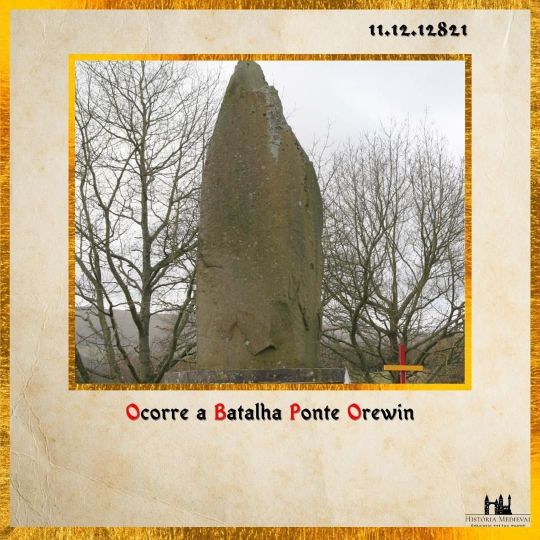
A batalha da ponte de Orewin, foi travada entre os exércitos inglês - liderado pelos Marcher Lords e galeses em 11 de dezembro de 1282, perto de Builth Wells, no meio do país de Gales. Foi uma derrota decisiva para os galeses porque seu líder, Llywelyn ap Gruffudd, foi morto, e isso efetivamente acabou com a autonomia do país de Gales. Em 11 de dezembro, o exército de Llywelyn ocupou uma encosta ao norte do rio Irfon, perto da vila de Cilmeri, colocada para repelir qualquer ataque do sul através da ponte de Orewin. O exército consistia em alguns milhares de lanceiros do norte de Gales, alguns homens do próprio teulu de Llywelyn e alguns arqueiros locais de Brecon - que traíram seus antigos aliados ingleses e se juntaram a Llywelyn, tendo ficado desapontado com o fracasso inglês na Batalha de Llandeilo Fawr. No total, o exército somava cerca de 7.000 soldados de infantaria e 160 de cavalaria. Um habitante local havia contado aos manifestantes sobre um vau do outro lado do rio Irfon, perto de sua confluência com o rio Wye, e eles enviaram a maioria de seus arqueiros para atacar os galeses no flanco. O exército galês se virou para encará-los, e os ingleses fizeram uma linha de batalha atravessando a ponte agora indefesa. Enquanto isso, os arqueiros ingleses dispararam contra os lanceiros galeses, enfraquecendo e desorganizando as tropas. A cavalaria pesada inglesa então atacou a retaguarda do exército. Os galeses sem líder e desmoralizados foram derrotados. Quando o exército galês fugiu, Llywelyn voltou às pressas. Nos arredores da luta, ele foi atacado e morto. _______ 📸 Monumento de Llywelyn em Cilmeri, que marca a batalha da ponte de Orewin. _______ Fonte - Philip Warner, Famous Battles of Wales #curitiba #idademedia #medieval #battle #batalha #middleAges #gales #cwb #historia #history https://www.instagram.com/p/CmB78eQua20/?igshid=NGJjMDIxMWI=
1 note
·
View note
Text

#the only Welsh king ever to rule over the entire territory of Wales... Thus#from about 1057 until his death in 1063#the whole of Wales recognised the kingship of Gruffudd ap Llywelyn. For about seven brief years#Wales was one#under one ruler#a feat with neither precedent nor successor.#A History of Wales#Historian John Davies#The Vale of Wales#Welsh history#Wales#VOW#Chapter 11#Page 34#Aerona#Morgen#Welsh mythology#Cyhyraeth#Welsh folklore
3 notes
·
View notes
Photo
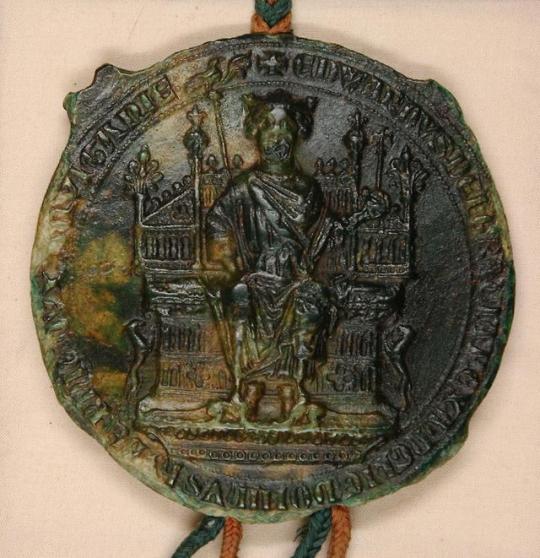

Great Seal of Edward I (reigned 1272 – 1307).
Edward I heard the news of his father's death while in Sicily, on his way home from the Crusades. He was crowned in 1274 in the grand new church of Westminster Abbey, which his father had had built.
Before the death of Henry III, Edward had crushed the rebellious barons in the Second Barons' War, and strengthened the royal administration's grip on England. As king himself, he was determined to subdue the Welsh and the Scots.
Llywelyn ap Gruffudd, the Prince of Wales, had refused to attend Edward's coronation or pay homage to him. In retaliation, Edward built a chain of great castles along the coast of North Wales, which cut the mountains of Snowdonia, Llywelyn's safe retreat, off from Anglesey, his source of grain. Llywelyn was killed in battle in 1282, and his brother Dafydd was hanged, drawn and quartered, the new punishment for traitors.
In 1290, Edward expelled the Jews from England, and after that he was forced to rely on Italian bankers for loans.
Edward I is known as the Hammer of the Scots, but he did not manage to subdue them during his lifetime. King Alexander III of Scotland died in 1286, and was succeeded by his granddaughter, Margaret, Maid of Norway. Edward decided to have his son marry her, and so arranged for her to be brought to Scotland, but she died on the way.
Now the Scots asked him to decide between several possible candidates for the Scottish throne. Edward chose John Balliol, but treated him as a puppet king, which angered the Scots. Balliol made an alliance with France, and war ensued.
The English crushed the Scots at the Battle of Dunbar in 1296, and Edward forced Balliol to abdicate. He went on a grand procession through the country, receiving the submission of many other important people, and seized the Stone of Scone, upon which the Scottish kings were traditionally crowned, and took it back to London.
This, of course, was not the end of it all. William Wallace lead the Scots to a victory at Stirling Bridge in 1297, but was then defeated the next year at Falkirk. He then embarked upon a guerrilla campaign, which lasted until his capture and execution in 1305.
Wallace's task was taken up by Robert the Bruce, who had himself crowned King in 1306, after which he spent much of his time in hiding. The next year, Edward set out to deal with him, but fell ill and died within sight of the Scottish border. His last order was for his son, Edward II, to carry his bones at the head of the army until the Scots had been defeated.
#history#military history#antisemitism#second barons' war#edwardian conquest of wales#edict of expulsion#first war of scottish independence#battle of dunbar#battle of stirling bridge#battle of falkirk#britain#england#wales#scotland#edward i#llywelyn ap gruffudd#dafydd ap gruffudd#alexander iii of scotland#margaret maid of norway#edward ii#john balliol#william wallace#robert the bruce
6 notes
·
View notes
Photo

Llafn y Cweri, Llanberis’ Sword | by Hefin Owen
#Llafn y Cweri#Llanberis' Sword#Padarn Lake#Wales#Snowdonia#National Park#Gwynedd#Landscape#Photography#Blade of the Giants#Princes of Gwynedd#Llywelyn Fawr#Llywelyn ap Gruffudd#Owain Glyndwr#Welsh history#sculpture#flickr#Hefin Owen
213 notes
·
View notes
Text
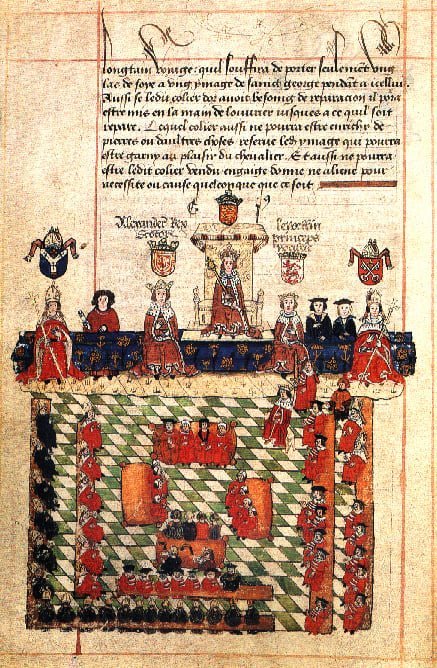
On December 25th 1251 Alexander III was knighted by Henry III of England. Born in 1241, he had become King on his father Alexander II's death in 1249, at the age of 7.
Alexander III was only a child when he became king but his reign would come to be seen as a golden age in Scottish history. Alexander needed to restore unity following the divisions of his minority, re-establish Scottish independence from the encroaching ambitions of England and finished his father’s work in recovering the Western Isles from Norway – a pretty big to-do list but he accheived all this and possibly more, it's such a shame we lost him aged only 37, but without his death we might never had the likes of Wallace, The Bruce and the Good Sir James Douglas to decorate our history.
Anyway, the story of his knighting by the English King is a tale to make you proud of him. Henry III was keen to assert his influence and see through a deal he made with Alexander II that their children would marry, so in 1251 Alexander III (now 10) came to York where he was knighted by Henry before marrying Henry’s daughter, Margaret who was aged 11 at the time. Henry began pressuring Alexander to swear fealty to Henry and England. Alexander sidestepped the demands, until after Edward I succeeded Henry III, when, with carefully chosen words, he swore this: “I become your man for the lands I hold of you in the Kingdom of England for which I owe homage, saving my Kingdom.” Basically saying his homage is only as a guest of the English but not in Scotland.
Of course after Alexander died Henry's son Edward, Longshanks stepped up the efforts to subjugate Scotland, heralding the time of the three Scottish heroes I mentioned earlier.
The pic is a 16th-century illustration of Edward I presiding over Parliament. The scene shows Alexander III and Llywelyn ap Gruffudd of Wales on either side of Edward; an episode that never actually occurred, but I would assume Edward would have loved to have these two serve under him.
15 notes
·
View notes
Text
Llywelyn’s Coronet

The only images that remain of Llywelyn’s coronet are in medieval manucsripts and paintings. It is one of the lost treasures of Wales. Llywelyn ap Gruffydd was the last prince to wear it (depicted above). During his reign, the King of England, Edward I, was making a series of war campaigns against Wales and Scotland in a desire to gain more and more land for the kingdom of England. In 1282, Llywelyn’s last campaign to force the English out had begun. In order to keep many of his treasures safe, including the coronet, he left them with the monks at Cymer Abbey. However, later that year, Llywelyn was killed. As Edward I pushed further and further into the last remnants of the Kingdom of Gwynedd he claimed Llywelyn’s treasure for his own. The very last prince of Wales, Llywelyn’s brother Dafydd, never got his chance to claim the coronet back as he was killed not long after. Edward I took the coronet to England as a symbol of his victory over the Welsh. He had the crown plated in gold to make it look even more impressive. It is highly likely that Llywelyn’s coronet was destroyed with the original English crown jewels in 1649 by order of Oliver Cromwell.
#wales#welsh history#llywelyn ap gruffudd#llywelyn the last#edward i#prince of wales#english history#oliver cromwell#medieval#middle ages
20 notes
·
View notes
Note
You said you could talk all day about Welsh castles. Handily enough, I brought a pen and paper to this lecture, so Imma pull up a chair and wait patiently for it to start. :D
this is SUCH an exciting ask thank you SO MUCH for letting me talk about castles. okay im gonna talk about my favourites
Caernarfon
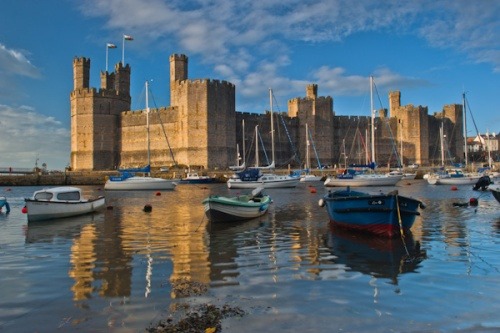

built as residence after edward 1st conquered wales in 1282, after he killed Prince of Wales Llywelyn ap Gruffudd.
edward sought to consolidate power and conquer independent Wales, and built the "iron ring of castles"
caernarfon castle was built in 5 years and was primarily built for 🌟 show 🌟 so edward could basically show how much money he had and how powerful he was
he liked roman history and built the towers with colourful stone, reminiscent of constantinople. the colour has since faded tho
however! just because it was built to show how extra edward was, it was also defensive. the only entrance are the 2 gatehouses, the queen's gate being at the shore for supplies and the kings gate
the kings gate was fearsome and built with holes to pour oil and boiling water down on attackers (also known as "murder holes")
if you survived that, you'd have 4 doors and 5 portcullises to deal with
the castle was briefly seized by a welsh revolution led by my man Madog ap Llywelyn in 1294, but taken back by troops later.
the welsh were deeply angry about Edward and how he conquered wales and killed the Prince. we hate being conquered
it was challenged again in 1403 + 1404 by national treasure Owain Glyndwr but he didn't manage to take it.
it was built on the docks and caernarfon is a walled town so its really very useful for defence.
Conwy
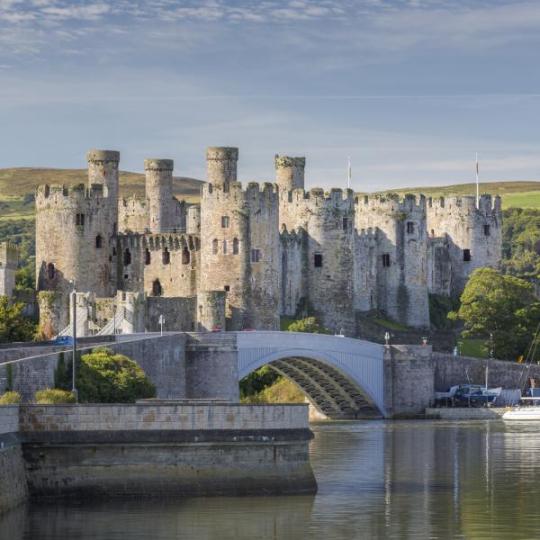
one of eddie boys iron ring of castles, finished construction in 1287 on conwy River
intended to be a mirror of the now ruined Deganwy castle
this was built purely for defence. its pretty much impregnable, due to its steep walls and the fact its on the river so you'd see an army coming a mile off. the bridge was the only way to march over
it was mainly a garrison town. the english kicked the welsh people out of most of the iron rings towns and made it illegal for us to live there. theres an old law thats never been struck out that you can still shoot a welsh man with an arrow off the walls if theyre in the towns. that's right folks, it was illegal for us to be in our own country.
it had 8 towers and 2 barbicans
it was attacked by Madogs rebellion the same time as caernarfon castle but they didn't take it
it fell into disuse but was hastily reactivated during the civil war in 1642
in 1646 it was besieged and ultimately surrendered
Deganwy
there aren't many images due to the fact it's in complete ruins but here's a digital reconstruction
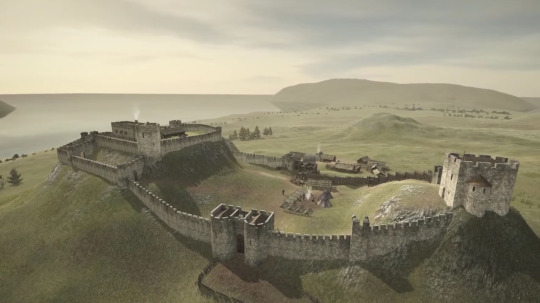
this site has a lot of history due to its highly naturally defensible position. evidence of prehistoric, iron age and Romano-British forts
situated on volcanic rock, and possibly the seat of Maelgwyn Gwynedd, circa 520-547
in AD812, it was damaged by lightning, then in AD822, what was left was destroyed by saxon invaders
robert of Rhuddlan rebuilt it in 1080. the history is vague and murky after this but it was in Welsh hands by 1191
in 1211, Llywelyn ap Iorwerth rebelled against king John, who previously let Llywelyn keep the castle. the castle was pre-emptively destroyed by the welsh to prevent it from falling into English hands (as I said, an enviably defensible position). Llywelyn rebuilt it again by 1228, THEN pre-emptively destroyed again
1245-54, Henry 3rd built it into a medieval fortification, but it was captured by Llywelyn ap Gruffudd.
along came edward 1st and he built conwy castle instead, Deganwy fell to ruins
nowadays, you can visit the few ruins, but apparently you have to be careful because the history is so rich and long and bloody you might accidentally come across human bones
Gwyrch


while beautiful, the castle itself is actually pretty new. it was built between 1810-1825 by Lloyd Hesketh, to honour his wife and their ancestors. (forget a wedding ring, build me a castle as a romantic gesture)
the aforementioned ancestors were the Llwyds (anglicised as lloyd) of Plas yn y Gwyrch. gwyrch was their ancestral home. situated in the castle estate are 2 iron age hillforts, a roman shrine, lead and silver mines, and medieval battle sites. the reason I include this castle is because of the surrounding history.
built directly on the coast, nestled into a huge hill, with a watchtower, very hard to capture. the watchtower is further along the hill and would give fair warning via flaming arrow if an army was coming.
during the WW2, it was home to 200 odd Jewish refugees
was abandoned was was renovated and then became the film site for im a celebrity
Beaumaris


another one of the colonisers iron ring castles, built in 1295
edward built it on an entirely new site, and is known as one of Britain's most sophisticated medieval military structures
almost geometric symmetry
practically impregnable due to the defences shown in the image. high inner defences with low circuit walls
ironically it saw very little action till the civil war and the construction wasn't completed
the first line of defence is an 18ft wide moat, and the dock is protected by a shooting deck
the sea gate had murder holes
if you managed to get through that gate, you'd be faced with 11 obstacles, including a barbican, more murder holes, 3 portcullises and several sets of doors. you had to get through this while dealing with arrow fire and boiling oil from all directions.
Once you get in, there's 6 massive interior towers, and then you're dead
Abergavenny
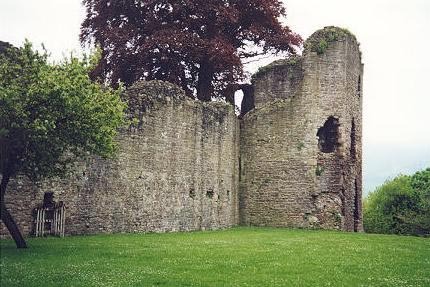
built in 1087 to the traditional motte and bailey configuration
it was initially timber but was rebuilt with stone at around 1100
by 1175, the castle was in the hands of William de Braose, who wanted to defeat his welsh rival, Seisyll ap Dyfnwal. he invited Seisyll to the castle along with several prominent Welsh men who opposed saxon rule, to propose reconciliation. the men and their armies were brutally massacred once inside the Great Hall. I think I read somewhere it was inspiration for the Red Wedding in game of thrones.
in 1182, Hywel ap Iorwerth of Caerleon attacked and severely damaged the castle
several rebuilds, most notable addition in the 1400s which was the barbican gatehouse. this was placed to defend against our Lord and saviour Owain Glyndwr and his epic rebellion
known as a very very very difficult castle to penetrate
Denbigh

another of edwards iron ring castles, built in 1282
walled town, colonised and populated by the english after booting the welsh out
naturally defensible position
the work wasn't completed in 1294 when Madog ap Llywelyn seized it
the castle kinda passed hands until the 14th century when it came into the possession of the mortimer family
it was attacked during the wars of the Roses and the town was burned
held by royalists in the civil war but taken in 1646 after a parliamentary siege
seized again by royalists in 1659 and they lay waste to the towers and walls of the castle
the town lay pretty much abandoned until the 19th century
the castle has 3 octagonal towers at the gatehouse, which was constructed of impressive decorative stonework to symbolise Royal authority
it also has 8 mural towers, barbicans and defensive terraces to protect it
I've hit the image limit and I can't think of other favourites rn but if I remember ill reblog and add!! thank you so much for letting me talk about welsh castles theyre a special interest of mine i hope u enjoyed
248 notes
·
View notes
Video
Ewloe Castle by Tony
Via Flickr:
Ewloe Castle, was built around 1257, is a relic of a brief triumph that the Welsh prince Llywelyn ap Gruffudd had over the English Crown and the Anglo-Norman Marcher Lords in the mid 13th century. Until then, this part of north-east Wales had been the starting point for repeated Norman invasions of Gwynedd for more than 150 years. But beginning in the early 1230s, the Princes of Gwynedd had started to gain the upper hand against the Anglo-Normans and Plantagenets who had taken territory in North Wales. Eventually by the late 1250s, the Welsh had reached Ewloe retaking lands up to the England–Wales border. A fortification had existed on or near the site since the Battle of Ewloe (Welsh: Brwydr Cwnsyllt) in 1157, when the Welsh successfully ambushed an English force under the command of Henry II (as they marched to Twthill at Rhuddlan). The English king only narrowly avoiding being killed himself having been rescued by Roger, Earl of Hertford.
#Ewloe Castle#Wales#Wepre park#albie#britain deeside#castle#europe#ian#valley#©2021 Tony Sherratt#2021 10 01 112956
9 notes
·
View notes
